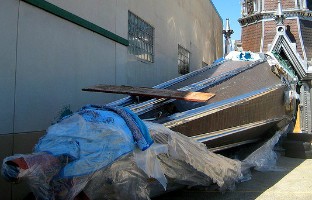The church is a steeple

Our
steeple came down a few weeks ago.
Thankfully,
it wasn't a windstorm or a lightning strike that brought it down. A 165-ton
crane lifted the steeple off the roof and laid it carefully on the ground.
After 50-plus years on top of our building, the steeple had
worn out beyond repair. The whole operation took three days. I spent a good
part of that time standing in the parking lot, staring skyward, intrigued not
just by the construction equipment but by the history being made before my
eyes.
More than
one of our church members remembers watching the steeple go up, and here it was
coming down. In the intervening years, a lot of church happened underneath:
pastors came and went; kids grew up and got married. Dear friends worshiped,
loved, celebrated, grieved and served.
Since the
construction began, I've been singing this old song I learned as a kid:
The church is not a building.
The church is not a steeple.
The church is not a resting place.
The church is the people.
The
people at my church know this, of course. In the course of planning and
fundraising for this project, we said repeatedly that it isn't about the
steeple itself. The church doesn't exist to have a building; it exists to serve
the world. The steeple points us up to the glory of God so that we can be led
out in service to our neighbors and our world.
We know
it's not about the building. But--and pardon me for quibbling with a children's
song--to say that the church is not a building is to underestimate the power of
place. To suggest that this steeple doesn't matter is to ignore the 50 years of
history that have taken place underneath it.
I've been
around here for less than three years. The steeple stood atop the church for 20
years before I was even born, and still I felt the tearing of the fiber of this
building as if it were happening to my own body. I felt the whacks of the
sledgehammers as if they were digging into my skin. I heard the creaking steel
as the top spire was lifted off, and I knew that we were saying goodbye to
something we'd never get back.
Things
come and go. Buildings, like bodies, wear out. Later this summer we'll
celebrate when the new steeple goes up, and someday we'll be telling our
grandchildren that we were here when it happened. I'm glad to be part of a
congregation that understands the need to let go of the old and make room for
the new.
A few
days after all the excitement, I was the only one around when the truck came to
take away the last dumpster full of debris. "Goodbye, old steeple," I thought,
and turned back toward my office.
But it
wasn't really the last of it--one piece remained. The six-foot copper cross
that topped the steeple all those years now sits in the foyer. It's dirty and
tarnished from half a century of exposure to the elements and the birds. But it
stands witness to all the people that made up the church in this time, all the
stories that happened here, all the prayers lifted high. Come August, this same
cross will be hoisted to the top of the new steeple, where hopefully it will
point us toward God for at least another 50 years.
We are
connected to each other--not just by the bonds of Christian fellowship, not
just by the way we serve and worship and learn together, but also by the place
in which we gather. Sure, the church is the people. But it's also a building, a
resting place and a steeple.





